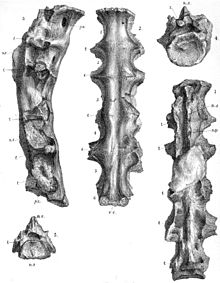Ornithodesmus
| Ornithodesmus | |
|---|---|

| |
| Illustration of the holotype sacrum in multiple views | |
| Scientific classification | |
| Domain: | Eukaryota |
| Kingdom: | Animalia |
| Phylum: | Chordata |
| Clade: | Dinosauria |
| Clade: | Saurischia |
| Clade: | Theropoda |
| Family: | †Dromaeosauridae |
| Genus: | †Ornithodesmus Seeley, 1887 |
| Species: | †O. cluniculus
|
| Binomial name | |
| †Ornithodesmus cluniculus Seeley, 1887
| |
Ornithodesmus (meaning "bird link") is a
Description
As it is only known from isolated vertebrae, little is known about the appearance of Ornithodesmus. The neural spines of the vertebrae are fused and form a blade over the 9.6 centimetres long sacrum, which is slightly arched. The bases of the neural spines form a lateral platform, and the first two vertebrae of the sequence have deep hollow cavities, which formed space for air sacs.[2]
Based on its apparent identity as a dromaeosaur, it was probably carnivorous, and likely measured about 1.8 meters (5.9 feet) long in life. Dromaeosaur teeth probably belonging to a velociraptorine are known from the same formation, but are too large to have belonged to Ornithodesmus; rather, these must have come from a theropod closer in size to the giant Utahraptor.[3]
History and classification

Ornithodesmus cluniculus was first described by
Later that year,
In 1993, Stafford C. Howse and Andrew Milner re-examined the type specimen of O. cluniculus and determined that Seeley had incorrectly referred the pterosaur species to this genus. They identified O. cluniculus as a theropod dinosaur. Specifically, they suggested it was a troodontid, based on its similarity to the supposed troodontid specimen BMNH R4463.[7] However, later study by Peter Makovicky and Mark Norell showed this specimen to be a dromaeosaurid; because of this mis-identification, they suggested Ornithodesmus was likely a dromaeosaurid as well.[8] Darren Naish and colleagues in 2001 argued against a dromaeosaurid identity for Ornithodesmus, suggesting instead it was related to the ceratosaurs or coelophysids.[2] However, those scientists later changed their opinions, publishing a paper in 2007 that agreed with previous studies and classifying Ornithodesmus as a dromaeosaurid.[3] A 2019 analysis placed Ornithodesmus in family Unenlagiidae, otherwise considered a subgroup of Dromaeosauridae.[9]
The more complete pterosaur specimens that had long been associated with the name Ornithodesmus were given a new name in 2001, Istiodactylus.[10]
See also
References
- ^ a b Seeley, H. (1887). "On a sacrum, apparently indicating a new type of Bird, Ornithodesmus cluniculus, Seeley, from the Wealden of Brook." Quarterly Journal of the Geological Society of London, 42: 206-211.
- ^ a b Naish, D. Hutt, and Martill, D.M. (2001). "Saurischian dinosaurs: theropods." in Martill, D.M. and Naish, D. (eds). Dinosaurs of the Isle of Wight. The Palaeontological Association, Field Guides to Fossils. 10, 242-309.
- ^ a b Naish, D. and Martill, D. M. (2007). "Dinosaurs of Great Britain and the role of the Geological Society of London in their discovery: basal Dinosauria and Saurischia." Journal of the Geological Society, London, 164(3): 493-510
- ^ Anonymous (1887). "Discussion (on Ornithodesmus and Patricosaurus)." Quarterly Journal of the Geological Society of London, 43: 219-220.
- ^ Seeley, H. (1901). Dragons of the Air. London: Methuen & Co. 239 pp.
- ^ Hooley, R.W. (1913). "The skeleton of Ornithodesmus latidens; an Ornithosaur from the Wealden Shales of Atherfield (Isle of Wight)." Quarterly Journal of the Geological Society, 69(1-4): 372-422.
- ^ Howse, S.C.B. and Milner, A.R. (1993). "Ornithodesmus—a maniraptoran theropod dinosaur from the Lower Cretaceous of the Isle of Wight, England." Palaeontology, 36: 425–437.
- ^ Norell, M.A. and Makovicky, P. (1997). "Important features of the dromaeosaur skeleton: Information from a new specimen." American Museum Novitates, 3215: 1-28.
- PMID 31333906.
- ^ Howse, Milner and Martill (2001). "Pterosaurs." in Martill, D.M. and Naish, D. (eds.). Dinosaurs of the Isle of Wight. The Palaeontological Association, London. pp. 324-335.
External links
 Media related to Ornithodesmus at Wikimedia Commons
Media related to Ornithodesmus at Wikimedia Commons
